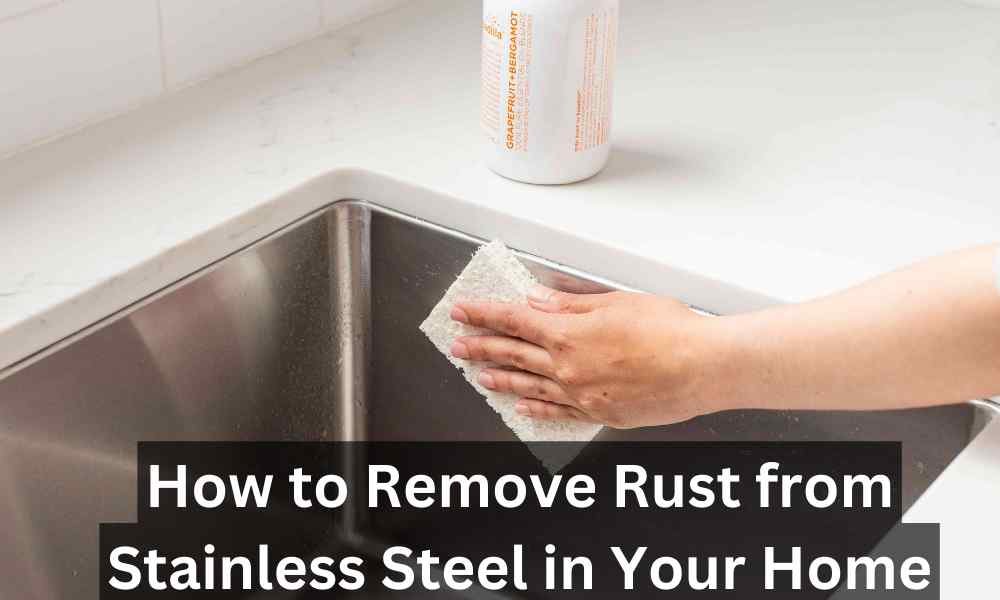Stainless steel is renowned for its durability and resistance to corrosion. However, despite its name, stainless steel can still develop rust under certain conditions, leaving unsightly stains on your appliances, utensils, or fixtures. Fortunately, Remove Rust from Stainless Steel, there are effective methods to remove rust from stainless steel right in the comfort of your home.
Understanding the Causes of Rust on Stainless Steel
Before diving into the removal process, it’s essential to understand why rust forms on stainless steel. Despite its name, stainless steel is not entirely immune to corrosion. Exposure to moisture, oxygen, and certain chemicals can lead to the formation of rust. Additionally, scratches or damage to the protective layer of chromium oxide on the surface of stainless steel can accelerate rusting.
Measures to Remove Rust from Stainless Steel
Prevention is always better than cure when it comes to rust. To minimize the risk of rust formation on your stainless steel items, consider the following precautions:
Keep stainless steel surfaces clean and dry.
Avoid using abrasive cleaners or steel wool that can scratch the surface.
Regularly inspect stainless steel items for signs of damage or corrosion.
Apply a protective coating or polish to maintain the integrity of the surface.
Materials Needed for Removing Rust from Stainless Steel
Before you begin the rust removal process, gather the following materials:
White vinegar
Baking soda
Lemon
Salt
Soft cloth or sponge
Commercial rust remover (optional)
Protective gloves
Methods for Removing Rust from Stainless Steel
Using Vinegar and Baking Soda
Vinegar and baking soda are two household staples known for their cleaning and rust-removing properties. Here’s how to use them:
Create a paste by mixing equal parts vinegar and baking soda.
Apply the paste to the rusted areas and let it sit for 10-15 minutes.
Scrub the affected areas with a soft cloth or sponge.
Rinse thoroughly with water and dry the stainless steel surface.
Using Lemon and Salt
Lemon juice contains citric acid, which can help dissolve rust, while salt acts as a mild abrasive. Follow these steps:
Squeeze lemon juice onto the rusted areas.
Sprinkle salt over the lemon juice to form a paste.
Allow the mixture to sit for 10-15 minutes.
Scrub the rusted areas with a soft cloth or sponge.
Rinse and dry the stainless steel surface.
Using Commercial Rust Removers
If the rust stains are stubborn or extensive, consider using a commercial rust remover. Follow the instructions provided by the manufacturer and wear protective gloves when handling these products.
Step-by-Step Guide for Each Method
Vinegar and Baking Soda Method:
Mix equal parts vinegar and baking soda to form a paste.
Apply the paste to the rusted areas.
Let it sit for 10-15 minutes.
Scrub the surface with a soft cloth or sponge.
Rinse thoroughly and dry.
Lemon and Salt Method:
Squeeze lemon juice onto the rusted areas.
Sprinkle salt over the lemon juice to create a paste.
Allow it to sit for 10-15 minutes.
Scrub the surface with a soft cloth or sponge.
Rinse and dry thoroughly.
Commercial Rust Remover Method:
Follow the instructions provided by the manufacturer.
Wear protective gloves and apply the rust remover to the affected areas.
Allow it to penetrate the rust for the recommended time.
Scrub or wipe off the rust residue.
Rinse the surface thoroughly with water and dry.
Additional Tips for Stubborn Rust Stains
For tough rust stains, consider using a rust remover specifically designed for stainless steel.
Use a soft-bristled brush or toothbrush to gently scrub the rusted areas.
Avoid using harsh chemicals or abrasive cleaners that can damage the stainless steel surface.
Maintenance Tips to Prevent Future Rust Formation
Regularly clean and dry stainless steel surfaces to prevent moisture buildup.
Apply a stainless steel polish or protective coating to maintain the shine and integrity of the surface.
Address any scratches or damage to the protective layer promptly to prevent rust from spreading.
In conclusion, removing rust from stainless steel can be achieved using simple household ingredients or commercial rust removers. By understanding the causes of rust formation and taking preventive measures, you can keep your stainless steel items looking clean and pristine for years to come.
FAQs (Frequently Asked Questions)
Can I use steel wool to remove rust from stainless steel?
No, steel wool can scratch the surface of stainless steel, making it more prone to rust formation. It’s best to use non-abrasive methods such as vinegar, lemon, or commercial rust removers.
Will vinegar damage stainless steel?
No, vinegar is safe to use on stainless steel and can effectively remove rust stains. However, avoid leaving vinegar on the surface for an extended period, as it may cause discoloration.
How often should I clean stainless steel to prevent rust?
It’s recommended to clean stainless steel surfaces regularly, especially in environments prone to moisture or humidity. Wiping down stainless steel items with a soft cloth after each use can help prevent rust formation.
Can I use lemon juice alone to remove rust from stainless steel?
Lemon juice contains citric acid, which can help dissolve rust stains. However, for tougher rust stains, it’s more effective to combine lemon juice with salt to create a paste.
Are commercial rust removers safe to use on food-related stainless steel items?
Always check the manufacturer’s instructions and safety precautions before using commercial rust removers on surfaces that come into contact with food. Rinse the surface thoroughly after using a rust remover to ensure it’s safe for food use.



